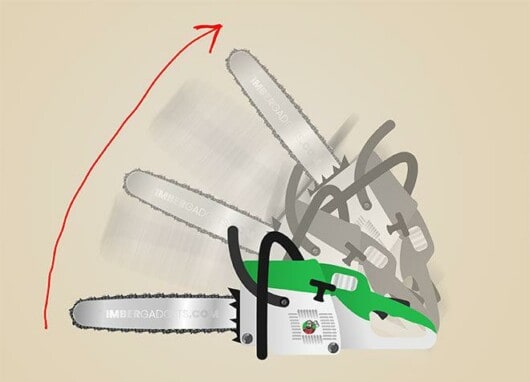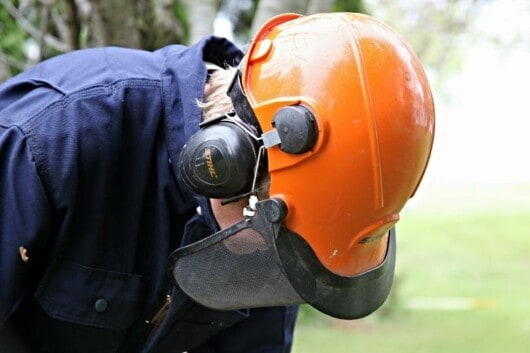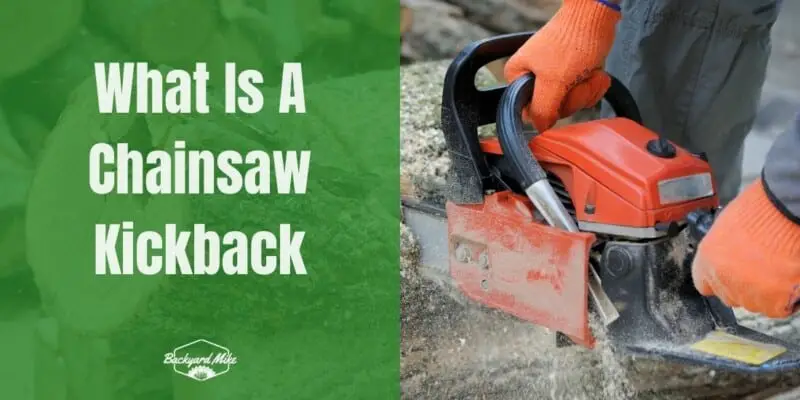Chainsaw kickback is one of the biggest causes of injuries when it comes to using a chainsaw. In fact, every year more than 36,000 chainsaw accidents are reported, with the most common reason being chainsaw kickback.
In this article, you will get to know all about chainsaws, what is chainsaw kickback, how chainsaw kickbacks happen, how to prevent them, and much more.
What is chainsaw kickback?
Chainsaw kickback is a phrase commonly used when discussing chainsaws and injuries that come with this powerful tool. It is the term used for describing the sudden jolt by the chainsaw in an upward direction. A chainsaw kickback injury is very serious while also being one of the most common causes of chainsaw accidents. Once your chainsaw decides to get back at you, there is next to nothing you can do about it. Hence, it is essential to be aware of chainsaw kickback, how it occurs, and how you can prepare for it.
Often, kickback can be caused when your chainsaw chain gets snagged. While the chain is snagged, the power from the chainsaw is still being drawn, and the power needs to go somewhere. According to Newton’s law, every action has an equal and opposite reaction. In this case, the kickback is the reaction. It means that the more your chainsaw chain gets stuck, the more severe the kickback will be.
The most common place that the incidence happens is in the kickback zone located on the chainsaw blade. It is a 90-degree angle at the top of the chainsaw. If you’re using this point of your chainsaw for cutting, it’ll be easy for the chainsaw blade to momentarily get pinched on the wood.
Additionally, if the chainsaw has been left for a long time, it can increase the chances of kickback. This happens as the chainsaw blade isn’t sharp and isn’t able to cut through the wood. Likewise, if the chainsaw is not tight enough, it’ll affect the efficiency of the chainsaw, increasing the risk of kickback. If the chainsaw ends up biting back, there will be nothing that you can do to stop it.
Instead, you’ll need to be prepared for when chainsaw kickback happens. You can choose to wear the right protective equipment before working. It is essential that you should wear the right PPE outfit before starting work. Since the chainsaw is likely to kick upwards, you’ll have to ensure that you’re wearing a protective helmet, preferably with a visor. Further, you’ll need to purchase the right type of gloves, boots, chaps, and jacket before you start working as it could be the difference between life and death in case the chainsaw decides to bite back.
Different kinds of chainsaw kickback
Chainsaw kickback is a common phrase used when you’re talking about chainsaw injuries. For ensuring absolute safety, it is essential that you should ensure your safety. It is important to be well versed with operating a chainsaw, the potential of chainsaw kickback accidents, and how to handle potential chainsaw kickback. Knowing the little details of chainsaw kickback can be the difference between completing the task and being on the receiving end of a serious injury.
An important detail to keep in mind is the different kinds of chainsaw kickback. Knowing about them will help you prepare for chainsaw kickback and avoid potential injuries.
1. Linear kickback
Linear kickback commonly occurs when the chainsaw chain at the end of the bar gets pinched shut by the object that you’re cutting. Therefore, if at any instance the chain gets pinched, or it is closed on either side of the object, the chainsaw will be pushed back at full intensity due to the excess power.
The bottom line is that you shouldn’t allow the chainsaw chain to be pinched and be extremely alert and careful.
2. Rotational kickback
Rotational kickback is another type of chainsaw kickback. It is not only common, but it is extremely dangerous as well.
It is the least controllable form of chainsaw kickback. It is initiated when an object touches the nose or guide bar’s tip, causing the chainsaw to go haywire and get “kicked” back towards your body with maximum force. The tip or nose is called the kickback zone.
Once the cutting angles in the teeth angle back, they tend to run on the woods instead of cutting into them. The grinding of the teeth onto the wood instead of into the wood will force the bar’s tip towards you.
Rotational kickback will likely catch you by surprise, and you’ll end up losing control of it and get a kickback, all in a split second.
3. Pull-in kickback
If the chainsaw you’re using hits a piece of wood or a nail on the other end, the chainsaw would be jerked forward and away from your grip.
What are some of the common kickback triggers?
There are many reasons why a chainsaw kickback can be triggered, and it is next to impossible to protect yourself once the chainsaw decides to fire back at you. The different types of chainsaw kickbacks were already mentioned above, but there are some common kickback triggers as well.

All of the above-mentioned incidents end up causing the guide bar to kick back, which will then cause the operator to lose control of the chainsaw and result in chainsaw kickback accidents. Other than the chainsaw kickback types mentioned above, there are a few minor triggers as well that can drastically increase the chances of a chainsaw kickback. The reasons that you can keep in mind to avoid chainsaw kickback injuries include –
- Dull chain rendering the blade unable to cut into the wood and bouncing off the surface
- Improper or neglected chainsaw maintenance, leaving your chainsaw in an unusable condition
- Incorrectly fitted parts causing the chainsaw to be in improper working condition
- Loose chainsaw tension triggering the kickback
- Wrongly sharpened chain angle, which bounces your chainsaw
- Loose rivets in the chainsaw
- Broken or cracked components of the chainsaw
How to prepare for chainsaw kickback?
It is next to impossible to stop the chainsaw once it decides to kick back at you. However, you can still prepare for the chainsaw kickback to prevent it, and surely you would have heard “prevention is better than cure”. This is applicable especially when it comes to handling a chainsaw as once the kickback occurs, you’ll be at the mercy of the chainsaw and luck. Knowing how to avoid chainsaw kickback will help you prepare and prevent potential chainsaw kickback injuries.
Wear protective equipment
First of all, you’ll need to wear authentic protective equipment. It is vital that you’re wearing the right gear. A high-quality helmet with a visor must be the primary choice because when chainsaw kickback occurs, your head will be one of the primary targets for injury.
Another important piece of equipment will be a pair of thick trousers or chainsaw chaps. Chainsaw chaps are preferred as they’re chainsaw resistant and are specifically designed for protecting the left side of your leg, which is another target for a kickback.

Other protective equipment must include gear like thick leather gloves, a jacket, heavy boots, and earplugs. You should invest in proper protective equipment as it could be the key difference between a slight niggle and a serious chainsaw kickback injury.
Read the instruction manual
Once you’re ready with the protective equipment, reading the instruction manual should be your next task. This is even more important if you’re a beginner. Your manual will have the necessary information on how to use the chainsaw safely. As long as you’re using the chainsaw safely, you’ll be able to prevent chainsaw kickback accidents.
Ensure that the chain brake is in a working condition
The chain break is one of the most important parts of the chainsaw. It is designed for stopping the chainsaw chain by simply applying the brake. The chain brake can be activated under kickback conditions, which will help prevent serious chainsaw kickback injuries.
Make use of low-kickback chains
Certain chainsaw chains are comparatively better for avoiding chainsaw kickback occurrence than others. It is essential that you choose the right chainsaw chain for your requirements. Using low-profile chains or semi-chisel chains will be ideal for beginners as they’re designed to incur less kickback. Full chisel chains come with square-cornered cutting teeth, allowing the saw to cut through wood quicker while also having a higher risk of kickback.
Making use of a sharp chain
A dull chainsaw can often result in chainsaw kickback as the chainsaw teeth aren’t able to cut through the wood. This causes the chain to get stuck and ends up causing kickback.
Be aware of falling tree trunks
If the nose of your chainsaw bar strikes a log or there is a hidden branch, you would be at the risk of kickback. It is essential that you’re extremely careful when cutting any trees as the risk would be even higher. It is important to consider where you are standing. If you’re using a ladder, you need to make sure that you’re as stable as possible as a kickback will affect your balance.
Pay close attention to the nose of your chainsaw bar
Make sure that you avoid the kickback zone when you’re pruning or cutting. Make sure that you’re using the correct side of the blade. The manufacturer’s manual will give you the information bespoke to the chainsaw.


